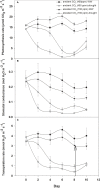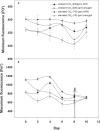Interactive effect of elevated CO2 and drought on physiological traits of Datura stramonium
- PMID: 36388510
- PMCID: PMC9644026
- DOI: 10.3389/fpls.2022.929378
Interactive effect of elevated CO2 and drought on physiological traits of Datura stramonium
Abstract
Rising atmospheric CO2 concentrations are known to influence the response of many plants under drought. This paper aimed to measure the leaf gas exchange, water use efficiency, carboxylation efficiency, and photosystem II (PS II) activity of Datura stramonium under progressive drought conditions, along with ambient conditions of 400 ppm (aCO2) and elevated conditions of 700 ppm (eCO2). Plants of D. stramonium were grown at 400 ppm and 700 ppm under 100 and 60% field capacity in a laboratory growth chamber. For 10 days at two-day intervals, photosynthesis rate, stomatal conductance, transpiration rate, intercellular CO2 concentration, water use efficiency, intrinsic water use efficiency, instantaneous carboxylation efficiency, PSII activity, electron transport rate, and photochemical quenching were measured. While drought stress had generally negative effects on the aforementioned physiological traits of D. stramonium, it was found that eCO2 concentration mitigated the adverse effects of drought and most of the physiological parameters were sustained with increasing drought duration when compared to that with aCO2. D. stramonium, which was grown under drought conditions, was re-watered on day 8 and indicated a partial recovery in all the parameters except maximum fluorescence, with this recovery being higher with eCO2 compared to aCO2. These results suggest that elevated CO2 mitigates the adverse growth effects of drought, thereby enhancing the adaptive mechanism of this weed by improving its water use efficiency. It is concluded that this weed has the potential to take advantage of climate change by increasing its competitiveness with other plants in drought-prone areas, suggesting that it could expand into new localities.
Keywords: electron transport rate; fluorescence; gas exchange; photosystem II activity; water use efficiency.
Copyright © 2022 Javaid, Florentine, Mahmood, Wasaya, Javed, Sattar, Sarwar, Kalaji, Ahmad, Worbel, Ahmed, Telesiński and Mojski.
Conflict of interest statement
JM was employed by companies Twój Swiat Jacek Mojski and Fundacja Zielona Infrastruktura. The remaining authors declare that the research was conducted in the absence of any commercial or financial relationships that could be construed as a potential conflict of interest.
Figures








Similar articles
-
Effects on Photosynthetic Response and Biomass Productivity of Acacia longifolia ssp. longifolia Under Elevated CO2 and Water-Limited Regimes.Front Plant Sci. 2022 Mar 31;13:817730. doi: 10.3389/fpls.2022.817730. eCollection 2022. Front Plant Sci. 2022. PMID: 35432396 Free PMC article.
-
Influence of elements of climate change on the growth and fecundity of Datura stramonium.Environ Sci Pollut Res Int. 2020 Oct;27(28):35859-35869. doi: 10.1007/s11356-020-10251-y. Epub 2020 Jul 24. Environ Sci Pollut Res Int. 2020. PMID: 32710358
-
Effect of Elevated CO2 and Drought on Biomass, Gas Exchange and Wood Structure of Eucalyptus grandis.Plants (Basel). 2022 Dec 28;12(1):148. doi: 10.3390/plants12010148. Plants (Basel). 2022. PMID: 36616277 Free PMC article.
-
Greater Biomass Production Under Elevated CO2 Is Attributed to Physiological Optimality, Trade-Offs in Nutrient Allocation, and Oxidative Defense in Drought-Stressed Mulberry.Antioxidants (Basel). 2025 Mar 25;14(4):383. doi: 10.3390/antiox14040383. Antioxidants (Basel). 2025. PMID: 40298623 Free PMC article.
-
Effects of water deficit stress on agronomic and physiological responses of rice and greenhouse gas emission from rice soil under elevated atmospheric CO2.Sci Total Environ. 2019 Feb 10;650(Pt 2):2032-2050. doi: 10.1016/j.scitotenv.2018.09.332. Epub 2018 Sep 29. Sci Total Environ. 2019. PMID: 30290346 Review.
Cited by
-
Phyto-microbiome to mitigate abiotic stress in crop plants.Front Microbiol. 2023 Aug 2;14:1210890. doi: 10.3389/fmicb.2023.1210890. eCollection 2023. Front Microbiol. 2023. PMID: 37601386 Free PMC article. Review.
-
Plant Microbiomes Alleviate Abiotic Stress-Associated Damage in Crops and Enhance Climate-Resilient Agriculture.Plants (Basel). 2025 Jun 19;14(12):1890. doi: 10.3390/plants14121890. Plants (Basel). 2025. PMID: 40573878 Free PMC article. Review.
References
-
- Aysu T., Durak H. (2015). Thermochemical conversion of datura stramonium l. by supercritical liquefaction and pyrolysis processes. J. Supercritical Fluids 102, 98–114. doi: 10.1016/j.supflu.2015.04.008 - DOI
LinkOut - more resources
Full Text Sources

